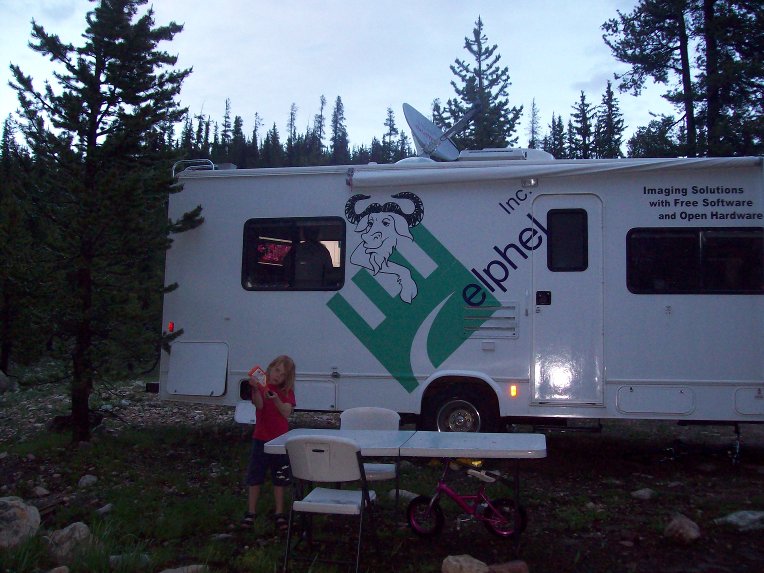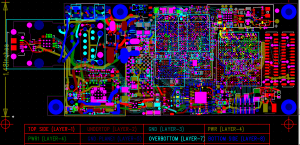10373A – new functionality added
by Andrey Filippov
It seems that those additional parts did fit on the board. I still need to restore some power connections and the legend on the board (it is also getting to be a real challenge – the smallest letters have to use 0.125mm (5 mil) lines and there is very little space between the components. It will need some time, but it is definitely doable. This is how the board looks now (click on the image to get the full size):
So to the 10373 features I listed initially in my May, 18 post:
- TMS320DM6467 as the CPU
- Xilinx Spartan 6 FPGA
- 256 MiB NAND flash
- 256 MiB DDR2 system memory
- 256 MiB DDR3 dedicated FPGA memory
- 48V DC over Ethernet cable
- GigE
- USB 2.0 host
- ATA port (to be used with the SATA bridge on the 10369 or similar I/O board)
- USB 1.1 device with micro USB connector. It is connected to the CPU serial port to be used as a system console and alternative boot source
Few more can be added:
- Two sensor ports, each can accommodate existent sensor front ends that work with NC353L cameras. Both sensors will be able to operate at full resolution/speed in parallel.
- SATA port with the flex cable connector. The connector pinout is made so it is possible to use flexible cables (single-layer) , not just 2-layer cable or flex PCB to achieve 100 Ohm impedance for the high-speed differential pairs. On the other end of that cable there will be either eSATA connector on the back panel of the camera or an adapter for the 64GB SSD used in some EEE PC computers. As you can see on Elphel wiki these 64GB memory can easily fit inside the camera – so no more CF cards. Same with 1.8″ HDD – we can make an adapter from the same flex cable – it addition to SATA signals it has both 3.3VDC and 5VDC power.
- Another flex cable connector has USB 2.0 (host) signals, including 5V power and additional 3.3V and 4 GPIO signals from the FPGA. It is possible to put just micro USB connector adapter on the camera back panel (it is likely to be combined with the eSATA one to simplify mounting) or have a 4-port USB hub (similar to the one in the 10369 board) and additional flex-cable connectors for internal USB or I2C internal add-ons (i.e compass).
- Clock/calendar with a super-capacitor power backup, similar to the one in our current 10369A board, but with the additional function – 10373 makes use of the alarm of that clock (it can be set up to a week in the future). Alarm output is used to re-power the camera after it turned itself off (and it can now). DC-DC converters still consume several mA when turned off, but it will be possible to use the camera with a very small solar panel in the wilderness unattended – either periodically recording images to the internal memory or using USB cellular module (if the area has coverage) to upload the images.
And here is where I’m working on this board – 110.965W 40.65168N. It is raining most of the time – day and night, so I have more time to work.


Nice photos with the 2 screens… and funny to see your vacation style. 😉 10373 will rock.
Haha, reading your reply I wondered which screens you ment and after looking at the picture again more carefully I had to laugh out loud when I found Andrey 🙂
BTW, what software is used for board layout? I suppose it is TopoR (http://freestyleteam.com ), is not it?
No, I used another proprietary software (no autorouters, just manual with DRC) I purchased some 5 years ago and never upgraded since as it (or any later versions) does not work on the computers I have. For that reason I had to keep a separate computer for this one program running even older proprietary operating system. I do not trust online registration of the newer versions of that OS so I format hard drives on the new computers as most of them are still purchased with unneeded OS preinstalled.
The latest design (10373) is made ising WINE – I tried it for the first time and after some tweaking was able to move that PCB software with all the custom libraries to my regular desktop. Not a perfect solution but at least I can use it in a familiar system and do such simple things as copy/paste between it and other applications. I am not really experienced in virus protection and other specifics of those popular OS so that my only computer was not connected to any network and I used USB flash to copy files to/from it.
That PCB software I’m using is outdated, so I would like to upgrade it or migrate to something else if it both has the features I need and can run on the computers I use. I would pay 50% on top of the license price if that software supports the OS of my choice by the software manufacturer.
Andrey
PS. Shura, on the other topic – I looked into your blog about soldering, I would recommend organic water-soluble fluxes as they work better on high density boards with fine pitch pins on the components. That flux does need removal – on the prototypes (I like to assemble the first boards myself – while mounting those tiny components I look at the same design from a different perspective) I use water, dish soap and a toothbrush.